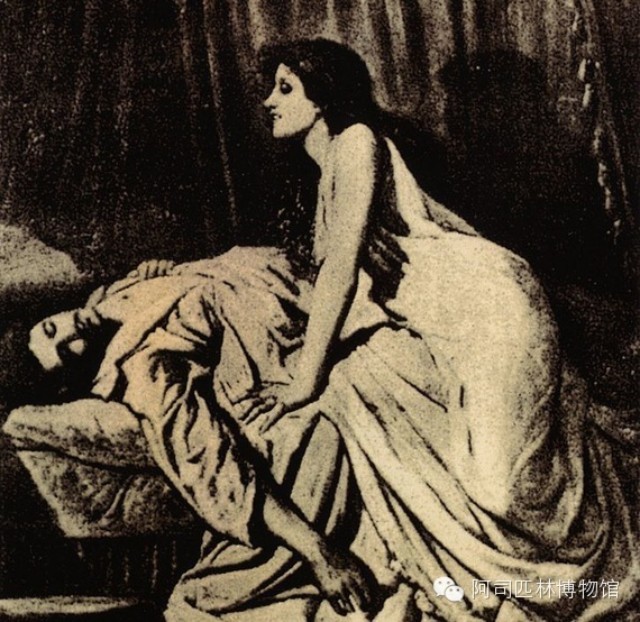
Look at the ancient superstition from the vampire tomb
Not all are rich and handsome.
our imaginary vampires seem to be gifted, rich and handsome, but in fact the source of the legend is the poor people who died of illness: the water coming out of their mouths from the decay of their digestive tract looks like they have sucked blood. The spread of superstition is probably due to people's confusion about the world after death. Just in case, in 1874, a father cut out the heart of his daughter's body and burned it; a brick was stuffed into the mouth of the grave.
in 1846, in Griswald, Connecticut, a man named Horace (Horace Ray) died of tuberculosis. Over the next six years, two of his adult sons died of the same disease. Two years ago, when his other son got sick, Ray's family and friends could only think of the only explanation: the two dead sons lived on the spirit of their living son in the underworld and made him thinner and thinner. In order to keep their living sons from getting worse, they dug up the bodies of their two dead sons and burned them.
Choose wedding dresses without train to get your desired appearance. Let them endow you with a demonstration of refined taste.
this event is not uncommon. In 1874, a Rhode Island native named William Ross (William Rose) exhumed the body of his own daughter and burned her heart; in 1875, to be on the safe side, patients with tuberculosis (the old term for tuberculosis) were removed and burned after death.
digging up and burning or manipulating bodies were popular in many western countries in the early 20th century. This is to prevent the emergence of vampires as people thought at that time, who thought that people who died of illness would climb out of their graves and suck the lives of living people.
the remains were unearthed in Italy in 2006 and belong to a 16th century woman. A brick was stuffed into the woman's mouth.
Today, we think of vampires as blood-sucking, cloaked count-or perhaps glittering, sexy teenagers-but throughout history, from ancient Greeks, Eastern Europeans to 19th century Americans, they all think that people who die of illness (sometimes villains) will become vampires and suck the spirit of the living from the underworld.
in order to prevent these demons from feeding on their villagers, surviving relatives will lock their bodies firmly in their graves, such as setting up obstacles in front of graves.
Last year, Bulgarian archaeologists found two skeletons in the town of Sozopol near the Black Sea, both pierced in the chest by iron bars-a typical local way of dealing with bodies suspected of being spoiled after death in the early 20th century. 100 such skeletons have been found in Bulgaria alone.
this summer, researchers exhumed a pile of remains in Poland, their heads chopped off and placed on their thighs-probably because the people who buried them didn't want them to find their heads, resurrect and become vampires.
A woman suspected of being a vampire was even buried in an Italian village with a brick in her mouth.
one of the reasons why vampire legends have spread to this day is that people are generally confused about their state after death. Obviously, the pagan Slavs were not aware of the process of biological decomposition, but even centuries later, people were misguided into thinking that the stiff limbs of dead bodies would become flexible and look like living people. Similarly, to unwitting villagers, the blood coming out of their mouths from the decay of the digestive tract looks like blood, and sometimes the teeth of the corpses are caught in the shroud, making them look as if they had been half eaten. Some people think this is in Ulysses, when Stephen sees a ghost he thinks he thinks, he yells "ghouls!" The reason. )
the same fear finally spread to the new world. During the tuberculosis epidemic, New Zealanders in the 19th century began to notice that relatives of TB patients began to get sick and lose weight after their loved ones died. At that time, the bacterial theory was not yet established, so a popular saying was that dead TB patients came back from the dead and ate the lives of their loved ones. In a small town in Connecticut, for example, the solution is thought to be to dig up the bodies of dead loved ones and place them according to the skull sign (the head is on the top and the femur is crossed in front of the chest).
the Scottish writer Emily Gerard (Emily Gerard) published an article called Transylvania superstition in 1885, which first recorded the Eastern European legend that led to the burial of vampires.
these restless souls, called Strygoy, are not bad in nature, but they look unlucky and may herald disease or disaster. However, what is even more evil are vampires, or Northferatu, and every farmer in Romania firmly believes that they are extremely evil, whether they come from heaven or hell.
borrowed from some of Gerard's works, Bramstock (Bram Stoker) 's Dracula in 1897 and the film adaptation of 1931 imprinted on the popular sense of fear the pale-faced, fanged vampire image we know today.
it is clear that at that time, vampires were more of a legend than a real threat. A book review of Dracula, published in the Guardian in 1897, said that count Dracula "could not die in a normal way, but remained half-dead for hundreds of years by sucking blood from the throats of the living." The consequences are so terrible that those who have been bitten are bound to become vampires. "
the newspaper praised Stoke as an influential writer, but was not optimistic about his genre choice.
"however, it is inappropriate to fill the whole book with fear."